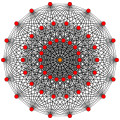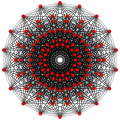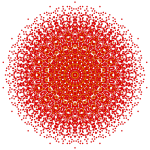Uniform Polytope
In 7-dimensional geometry , 231 is a uniform polytope , constructed from the E7 group.
Its Coxeter symbol is 231 , describing its bifurcating Coxeter-Dynkin diagram , with a single ring on the end of the 2-node branch.
The rectified 231 is constructed by points at the mid-edges of the 231 .
These polytopes are part of a family of 127 (or 27 −1) convex uniform polytopes in 7-dimensions , made of uniform polytope facets and vertex figures , defined by all permutations of rings in this Coxeter-Dynkin diagram :
2_31 polytope
The 231 is composed of 126 vertices , 2016 edges , 10080 faces (Triangles), 20160 cells (tetrahedra ), 16128 4-faces (3-simplexes ), 4788 5-faces (756 pentacrosses , and 4032 5-simplexes ), 632 6-faces (576 6-simplexes and 56 221 vertex figure is a 6-demicube .
Its 126 vertices represent the root vectors of the simple Lie group E7 .
This polytope is the vertex figure for a uniform tessellation of 7-dimensional space, 331
Alternate names
E. L. Elte named it V126 (for its 126 vertices) in his 1912 listing of semiregular polytopes.[ 1] It was called 231 by Coxeter for its bifurcating Coxeter-Dynkin diagram , with a single ring on the end of the 2-node sequence.
Pentacontihexa-pentacosiheptacontihexa-exon (Acronym laq) - 56-576 facetted polyexon (Jonathan Bowers)[ 2]
Construction
It is created by a Wythoff construction upon a set of 7 hyperplane mirrors in 7-dimensional space.
The facet information can be extracted from its Coxeter-Dynkin diagram ,
Removing the node on the short branch leaves the 6-simplex . There are 576 of these facets. These facets are centered on the locations of the vertices of the 321 polytope,
Removing the node on the end of the 3-length branch leaves the 221 . There are 56 of these facets. These facets are centered on the locations of the vertices of the 132 polytope,
The vertex figure is determined by removing the ringed node and ringing the neighboring node. This makes the 6-demicube , 131 ,
Seen in a configuration matrix , the element counts can be derived by mirror removal and ratios of Coxeter group orders.[ 3]
E7
k -facefk
f0
f1
f2
f3
f4
f5
f6
k -figuresnotes
D6
( )
f0
126 32
240
640
160
480
60
192
12
32
6-demicube E7 /D6 = 72x8!/32/6! = 126
A5 A1
{ }
f1
2
2016 15
60
20
60
15
30
6
6
rectified 5-simplex E7 /A5 A1 = 72x8!/6!/2 = 2016
A3 A2 A1
{3}
f2
3
3
10080 8
4
12
6
8
4
2
tetrahedral prism E7 /A3 A2 A1 = 72x8!/4!/3!/2 = 10080
A3 A2
{3,3}
f3
4
6
4
20160 1
3
3
3
3
1
tetrahedron E7 /A3 A2 = 72x8!/4!/3! = 20160
A4 A2
{3,3,3}
f4
5
10
10
5
4032 *
3
0
3
0
{3} E7 /A4 A2 = 72x8!/5!/3! = 4032
A4 A1
5
10
10
5
*
12096 1
2
2
1
Isosceles triangle E7 /A4 A1 = 72x8!/5!/2 = 12096
D5 A1
{3,3,3,4}
f5
10
40
80
80
16
16
756 *
2
0
{ }
E7 /D5 A1 = 72x8!/32/5! = 756
A5
{3,3,3,3}
6
15
20
15
0
6
*
4032 1
1
E7 /A5 = 72x8!/6! = 72*8*7 = 4032
E6
{3,3,32,1 }
f6
27
216
720
1080
216
432
27
72
56 *
( )
E7 /E6 = 72x8!/72x6! = 8*7 = 56
A6
{3,3,3,3,3}
7
21
35
35
0
21
0
7
*
576 E7 /A6 = 72x8!/7! = 72×8 = 576
Images
Coxeter plane projections
E7
E6 / F4
B6 / A6
A5
D7 / B6
D6 / B5
D5 / B4 / A4
D4 / B3 / A2 / G2
D3 / B2 / A3
2k 1 in n dimensions
Space
Finite
Euclidean
Hyperbolic
n
3
4
5
6
7
8
9
10
Coxeter
E3 =A2 A1
E4 =A4
E5 =D5
E6
E7
E8
E9 =
E
~
8
{\displaystyle {\tilde {E}}_{8}}
8 +
E10 =
T
¯
8
{\displaystyle {\bar {T}}_{8}}
8 ++
Coxeter
Symmetry
[3−1,2,1 ]
[30,2,1 ]
[[31,2,1 ]]
[32,2,1 ]
[33,2,1 ]
[34,2,1 ]
[35,2,1 ]
[36,2,1 ]
Order
12
120
384
51,840
2,903,040
696,729,600
∞
Graph
-
-
Name
2−1,1
201
211
221
231
241
251
261
Rectified 2_31 polytope
The rectified 231 is a rectification of the 231 polytope, creating new vertices on the center of edge of the 231 .
Alternate names
Rectified pentacontihexa-pentacosiheptacontihexa-exon - as a rectified 56-576 facetted polyexon (acronym rolaq) (Jonathan Bowers)[ 4]
Construction
It is created by a Wythoff construction upon a set of 7 hyperplane mirrors in 7-dimensional space.
The facet information can be extracted from its Coxeter-Dynkin diagram ,
Removing the node on the short branch leaves the rectified 6-simplex ,
Removing the node on the end of the 2-length branch leaves the, 6-demicube ,
Removing the node on the end of the 3-length branch leaves the rectified 221 ,
The vertex figure is determined by removing the ringed node and ringing the neighboring node.
Images
Coxeter plane projections
E7
E6 / F4
B6 / A6
A5
D7 / B6
D6 / B5
D5 / B4 / A4
D4 / B3 / A2 / G2
D3 / B2 / A3
See also
Notes
^ Elte, 1912
^ Klitzing, (x3o3o3o *c3o3o3o - laq)
^ Coxeter, Regular Polytopes, 11.8 Gossett figures in six, seven, and eight dimensions, p. 202-203
^ Klitzing, (o3x3o3o *c3o3o3o - rolaq)
References
Elte, E. L. (1912), The Semiregular Polytopes of the Hyperspaces , Groningen: University of Groningen H. S. M. Coxeter , Regular Polytopes , 3rd Edition, Dover New York, 1973Kaleidoscopes: Selected Writings of H.S.M. Coxeter , edited by F. Arthur Sherk, Peter McMullen, Anthony C. Thompson, Asia Ivic Weiss, Wiley-Interscience Publication, 1995, ISBN 978-0-471-01003-6 [1]
(Paper 24) H.S.M. Coxeter, Regular and Semi-Regular Polytopes III , [Math. Zeit. 200 (1988) 3-45] Klitzing, Richard. "7D uniform polytopes (polyexa)" . 































